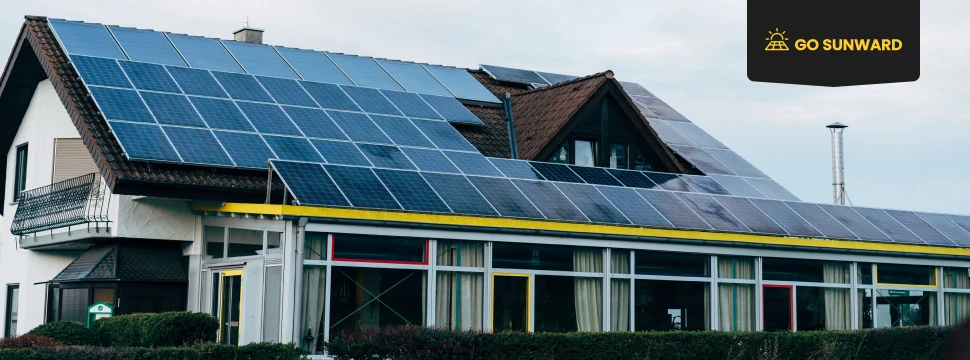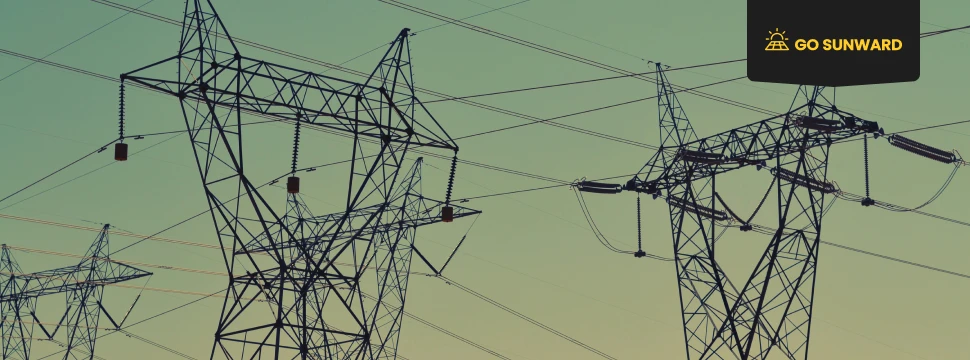How Do Solar Panels Work? From Sunlight To Energy Explained ☀️
In today’s rapidly evolving world, the significance of solar energy has grown exponentially as policymakers, individuals and businesses look to sustainable and renewable sources to meet rising energy demand. The shift towards renewable energy sources, like solar power, has gained momentum due to concerns about climate change, energy security, and the finite nature of fossil fuels. This has led to a widespread recognition of solar energy as a pivotal player in the global energy landscape. At the heart of this transformation are solar panels, devices that enable the efficient conversion of sunlight into usable forms of energy. While the importance of solar power is undeniable and increasingly acknowledged, the details of how solar panels work are less recognised.
This article will answer the question ‘how do solar panels work’, and take a deep dive into the technology that is used, the science behind their operation and the components they are made from. We won’t cover the very simple basics like what is a solar panel, for that you’ll have to read our more basic guides.
By understanding the mechanics of solar energy conversion, individuals, communities, businesses, and policymakers gain the knowledge necessary to make informed decisions about adopting solar power systems. This understanding empowers them to take advantage of the economic and environmental benefits solar energy offers. From reducing electricity bills and mitigating carbon footprints to fostering energy independence and creating new job opportunities, the implications of embracing solar power extend far beyond just simple energy production.
A Brief Recap On Panels
The sun presents an ample supply of energy to meet the global power demand, and unlike fossil fuels, this resource is inexhaustible. Solar energy, being both renewable and devoid of carbon emissions, faces limitations only in how efficiently and cost-effectively we can transform it into electricity.
Luckily we have solar panels to help us with this! They are devices that convert captured sunlight into energy. At the core of solar panels lie solar PV cells, fundamental units responsible for converting sunlight into electricity. These solar cells predominantly consist of semiconductor materials, with silicon being the most popular and common choice. There are three main technology types of solar panels, each offering distinct advantages and applications.
- Monocrystalline solar cells exhibit a uniform and single-crystal structure, meticulously grown to maximize efficiency. This precision gives them an edge in efficiency compared to their polycrystalline counterparts.
- On the other hand, polycrystalline solar cells possess a mosaic-like structure composed of numerous smaller crystals. While they might exhibit slightly lower efficiency levels, they tend to be more cost-effective to produce.
- Thin-film solar panels employ slender layers of semiconductor materials, like amorphous silicon, cadmium telluride, or copper indium gallium selenide (CIGS). This unique thin-film approach yields solar panels that are not only adaptable but also lightweight, rendering them well-suited for integration into diverse surfaces, even those that are curved or irregular in shape.
They are encased in a protective and transparent layer to safeguard these solar cells and bolster light absorption. This layer is often constructed from tempered glass. This robust material protects against environmental factors while allowing ample sunlight to permeate and interact with the solar cells.
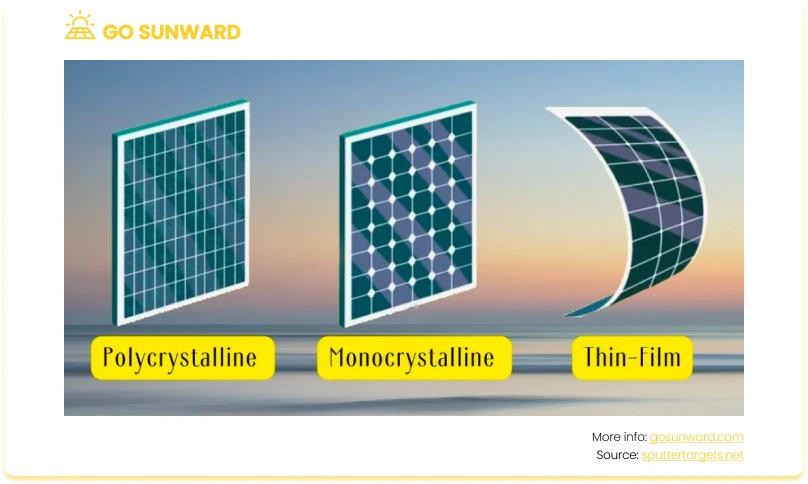
The Science Behind Solar Panels
In the field of generating electricity from solar energy, two prominent categories of technologies have emerged as frontrunners: photovoltaics (PV) and concentrating solar-thermal power (CSP). These innovative systems efficiently convert the sun’s radiant energy into harnessed electrical power.
The fundamental difference between solar PV and CSP is their approaches to transforming solar energy into electricity. Solar PV systems directly convert sunlight into electrical power using photovoltaic cells. In contrast, solar CSP systems focus sunlight to generate thermal energy, which is then utilized to produce electricity through steam-driven turbines. Go here to see how much energy a solar panel can produce!
How Do Solar Panels Work: Solar PV
Solar photovoltaic (PV) technology uses the photovoltaic effect—an occurrence in which photons, the elemental components of light, strike the surface of a semiconductor material, such as silicon. This interaction imbues electrons within the material with energy, liberating them from their atoms.
As these electrons, each carrying a negative charge, migrate towards the front surface of the solar cell, an electrical disparity emerges between the cell’s front and rear surfaces. This disparity creates a voltage potential similar to the positive and negative terminals of a battery. The cell’s electrical conductors capture these electrons. Upon linking these conductors to an external load, like a battery, an electric current courses through the circuit. This current constitutes direct current (DC), as the electrons traverse the circuit in an unbroken, one-way trajectory. Ultimately, this direct current is transformed into alternating current (AC) by using inverters to create an electrical current. You’ll hear more about inverters below, or click here for a more detailed look at the technology.
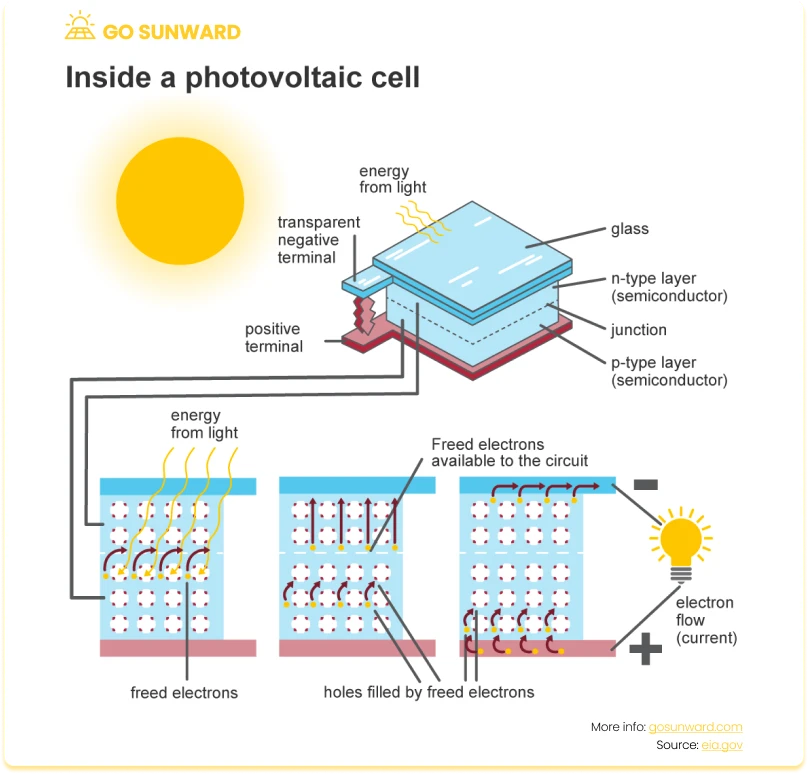
How Do Solar Panels Work? Solar CSP
Solar CSP systems use mirrors or lenses to focus sunlight onto a receiver, which is converted into thermal energy. This intensified sunlight can achieve exceptionally high temperatures, and this heat is subsequently employed to generate steam. The steam propels a turbine, which is connected to a generator, resulting in electricity production.
Notably, CSP technology often integrates thermal energy storage systems, enabling electricity generation even during periods without sunlight. This feature ensures a more reliable and dispatchable power supply. Solar CSP is typically employed in sizeable utility plants and is a feasible choice for regions endowed with substantial direct sunlight.
Two primary types of CSP systems exist:
- Parabolic Trough Systems: These utilize elongated curved mirrors, resembling parabolic troughs, to focus sunlight onto a linear receiver tube positioned at the focal point of the trough. This receiver tube contains a heat transfer fluid that absorbs the concentrated sunlight and subsequently heats up.
Solar Power Tower Systems: In this configuration, an array of mirrors is arranged to track the sun’s movement and reflect sunlight onto a central receiver tower. At the tower’s apex, a heat-absorbent material is situated, which becomes heated as it absorbs the concentrated sunlight.
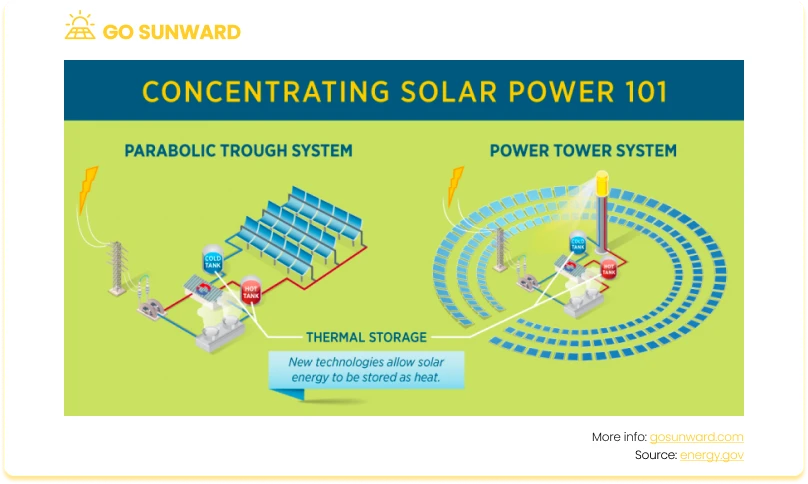
How Do Solar Panels Work? The Conversion Process
Both solar CSP and photovoltaic systems necessitate the use of solar panel inverters. These devices transform the direct current (DC) electricity produced by solar panels or CSP receivers into alternating current (AC) electricity, maintaining a utility frequency suitable for powering homes and businesses. This conversion holds immense importance as most of our appliances and devices are designed to operate on AC power. This AC output can be seamlessly integrated into a larger electrical grid or utilized within localized off-grid electrical networks.
Solar inverters offer more than just mere conversion; they also optimise energy generation and system efficiency to ensure peak performance. Employing a monitoring approach, these devices continually supervise the performance of solar panels, making dynamic adjustments to the conversion process. This real-time fine-tuning is pivotal in upholding the energy output at its optimal level, thereby maximizing the overall efficiency of the solar system.
Moreover, solar inverters serve a dual purpose by acting as the crucial link between solar panels and a home’s electrical distribution panel. This strategic positioning grants them a vital role in ensuring the smooth functioning of the entire energy system. Without adequate inverters, solar panels won’t work efficiently. By integrating advanced technology, contemporary inverters include sophisticated switches that can effortlessly connect or isolate your solar energy system from the wider power grid.
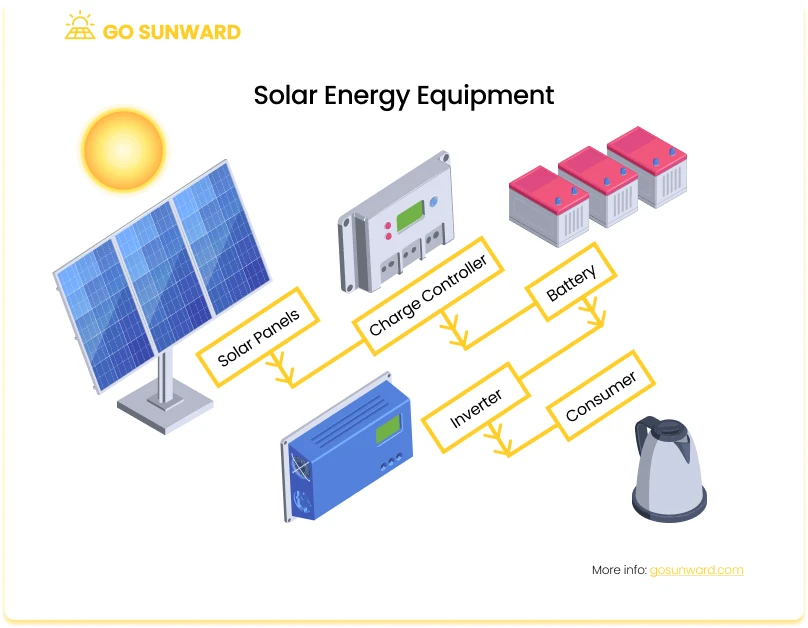
How Do Solar Panels Work? All Eyes On Meters
As solar energy adoption continues to expand globally, integrating solar panels with the electrical grid has become a crucial facet of maximizing the benefits of renewable energy. As mentioned, the integration process involves inverters which allow for synchronization with the grid’s frequency and voltage levels, ensuring a smooth and safe flow of electricity back and forth. Besides inverters, meters are also very important.
One of the most revolutionary aspects of grid-connected solar systems is the concept of net metering. When solar panels generate more electricity than is currently being consumed on-site, the excess energy is fed back into the grid. This surplus electricity is credited to the consumer’s account, effectively “turning back” the utility meter. During periods when the solar panels are not producing sufficient energy (e.g., nighttime or cloudy days), consumers draw electricity from the grid as usual. The utility meter tracks this energy flow both ways—consumption and production.
Utility meters play a pivotal role in the net metering process. Traditional utility meters only measured energy consumption, but with the advent of net metering, bidirectional or smart meters were introduced. These advanced meters can track both energy consumption and production, allowing consumers and utility companies to accurately account for the energy exchanged with the grid. This technology ensures that consumers receive credit for the excess energy they contribute, thereby incentivizing the adoption of solar energy systems.
How Are Solar Panels Made?
The manufacturing of solar panels involves a meticulous process, starting with sand and culminating in functional units capable of converting sunlight into electricity. This process, which includes transforming silicon into ingots and then wafers, is essential for producing solar cells and then panels. For more detailed information on the exact manufacturing process and the raw materials used, click here.
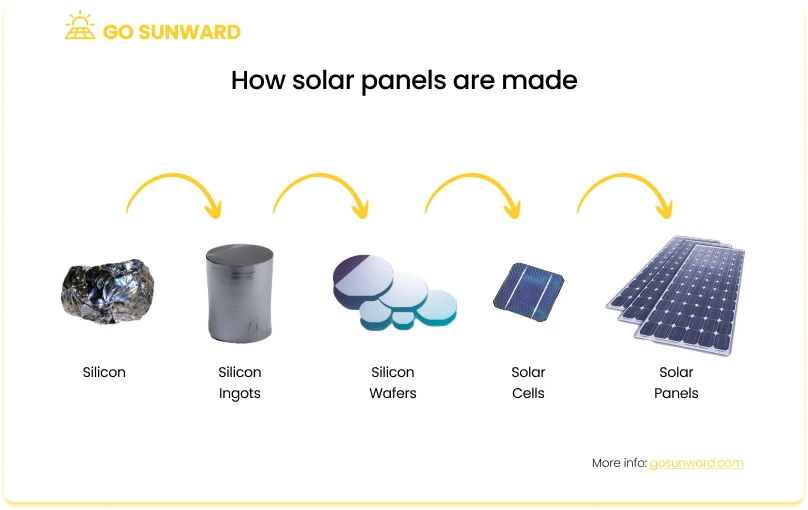
How Much Energy Does A Solar Panel Generate?
The amount of energy a solar panel can generate depends on various factors, including its size, efficiency, location, and weather conditions.
Size & Effeciency
The size of the solar panel plays a significant role in determining its energy generation capacity. Generally, larger solar panels have a higher wattage rating, which means they can produce more electricity. The wattage rating is often indicated on the solar panel itself and estimates its maximum power output under ideal conditions.
The efficiency of a solar panel is crucial in determining its energy generation potential. Solar panel efficiency refers to the amount of sunlight that can be converted into electricity. Higher-efficiency panels can generate more electricity from the same amount of sunlight, making them more efficient in capturing solar energy and producing electricity.
Sunlight Intensity, Angle, & Shading
The location of the solar panel is essential in determining its energy generation. The amount of sunlight available varies depending on the geographical location and climate. Areas with high solar radiation levels, such as desert regions, are more conducive to solar energy generation than regions with frequent cloud cover or limited sunlight.
Solar panels are most efficient when sunlight hits them perpendicularly. As the angle deviates from the optimal orientation, the efficiency decreases. This is why solar panel tilt angles are often adjusted based on the geographical location to maximize energy production.
Shading is another significant factor that can drastically reduce solar panel efficiency. Even partial panel shading can result in power losses, as shaded cells cannot contribute to the overall energy production. This is why careful consideration of shading from nearby buildings, trees, or other obstructions is vital during the installation process.
Proper Installation and Orientation
The installation and orientation of solar panels play a pivotal role in their efficiency. To make sure solar panels work efficiently, they need to be installed correctly. Proper installation ensures that panels are securely mounted, minimizing the risk of damage from weather events and ensuring optimal airflow to dissipate heat. Correct orientation involves aligning the panels with the sun’s path to maximize exposure to sunlight. For example, in the Northern Hemisphere, panels are typically oriented southward.
Solar tracking systems are advanced mechanisms that enhance efficiency by allowing solar panels to follow the sun’s movement throughout the day. These systems come in various types, such as single-axis and dual-axis trackers, and are particularly beneficial in regions where sunlight angles change significantly throughout the year. By constantly adjusting panel angles to face the sun, tracking systems can increase energy output by 20% to 40% compared to fixed installations.
How Much Do Solar Panels Cost?
The cost of solar panels has significantly declined over the past decade, making renewable energy more accessible to a broader range of individuals, businesses, and communities. Several factors contribute to the overall cost of solar panels, including the size of the system, installation expenses, regional variations, and the quality of components. According to our research, the average cost of solar panels, including installation, was around $2.50 to $5 per watt. However, these costs can vary widely based on factors like location, incentives, and technological advancements.
One major driving force behind the reduced cost of solar panels has been the continuous advancements in technology and manufacturing processes. Improved solar cell efficiency, streamlined production methods, and increased competition among manufacturers have collectively made solar panels more affordable. Additionally, various financial incentives, such as government tax credits, rebates, and net metering programs, have played a crucial role in lowering the upfront costs for consumers and encouraging solar adoption.
It’s important to note that while the initial investment in solar panels may seem substantial, the long-term benefits can far outweigh the upfront expense, most notably environmental benefits (LINK). Solar panels have the potential to significantly reduce or even eliminate electricity bills over their lifespan, which typically ranges from 25 to 30 years or more. Moreover, as solar technology continues to evolve, it’s likely that costs will continue to decrease while efficiency and performance improve, making solar energy an increasingly attractive and economically viable option for energy consumers.
Are Solar Panels Worth It?
Deciding whether investing in solar panels is worth it involves carefully evaluating multiple factors tailored to your unique circumstances. One of the primary considerations is the potential for substantial energy savings. Over time, solar panels can significantly reduce or even eliminate your electricity bills. However, this depends on factors such as your energy consumption patterns, the size and efficiency of the solar installation you choose, and the prevailing local electricity rates.
An important aspect to weigh is the initial investment required. While the cost of solar panels has decreased, there is still an upfront expense associated with purchasing and installing them. It’s crucial to analyze whether the long-term financial gains in terms of reduced energy bills will eventually offset this initial cost outlay.
Governments and local authorities often provide financial incentives to encourage the adoption of solar energy. These can be solar tax credits, rebates, and net metering programs that allow you to sell excess energy back to the grid. These incentives can significantly mitigate the overall expense and enhance the economic viability of solar panels.
Another critical consideration is the environmental impact. By harnessing the sun’s energy, solar panels generate clean and renewable electricity, reducing reliance on fossil fuels and cutting down your carbon footprint. If you prioritize sustainability and are committed to minimizing your environmental contribution, the environmental benefits of solar panels might strongly influence your decision.
The impact on your home’s value is another aspect to think about. Solar panels can enhance the resale value of your property, as an increasing number of homebuyers are attracted to energy-efficient and eco-friendly features. This can make your home more appealing and potentially add value when you decide to sell.
The effectiveness of solar panels also depends on your geographic location and the amount of sunlight your area receives. Sunnier regions generally yield greater electricity generation, leading to more substantial savings. Moreover, installing solar panels provides a degree of energy independence, allowing you to generate your electricity and potentially mitigate the effects of power outages or grid disruptions.
You may also want to consider your tax credits when deciding if solar is worth it or not: Do you get a tax refund from installing solar?
Future Innovations
The field of solar panel technology is marked by continuous research and development aimed at enhancing efficiency, affordability, and environmental sustainability. Researchers are exploring novel materials, innovative designs, and new manufacturing processes to revolutionize how we can capture and utilize solar energy.
R&D: Researchers are constantly working to boost the efficiency of solar panels, enabling them to generate more electricity from the same amount of sunlight. This involves refining materials, improving light-capturing mechanisms, and minimizing energy losses within the panels. Enhanced efficiency not only increases the energy yield but also reduces the number of panels required for a given energy output, thereby decreasing installation costs.
Sustainability: is a critical consideration in solar panel innovation. Efforts are being made to reduce the environmental impact of solar panel manufacturing and disposal. This includes exploring eco-friendly materials, optimizing production processes to reduce energy consumption, and developing strategies for recycling and reusing solar panels at the end of their lifecycle. By addressing these aspects, the solar industry aligns more closely with the broader environmental conservation goals.
Integration with Energy Storage and Smart Grids: The future of solar energy goes beyond just generating electricity. Integrating solar panels with energy storage solutions, such as advanced batteries, enhances the capability to store excess energy for use during cloudy periods or at night. Furthermore, the integration of solar panels with smart grids allows for more efficient distribution of energy, optimizing consumption patterns and further reducing the reliance on non-renewable energy sources.
Conclusion
So, how do solar panels work? This article has effectively answered this question and explored the remarkable capabilities of solar panels. These devices efficiently transform the sun’s abundant energy into usable electricity through the application of photovoltaic and concentrating solar-thermal power technologies.
Solar panels are crucial in the global pursuit of a low-carbon and more sustainable energy landscape. It can counteract the adverse effects of climate change and the depletion of finite fossil fuel resources.
The adoption of solar power carries far-reaching benefits that extend beyond environmental considerations. It is pivotal in enhancing energy security by diversifying our energy sources, reducing dependence on vulnerable supply chains, and contributing to more resilient energy grids.

